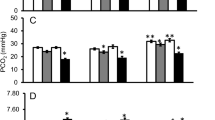Summary
Japanese quail,Coturnix coturnix japonica, which were acclimated to a simulated altitude of 6100 m for six weeks were compared with control quail maintained at sea level. Body weight initially decreased in both groups, and by the end of six weeks the altitude quail weighed an average of 8% less than the control quail (Fig. 1). Compared with the controls, the altitude birds exhibited mean increases in hematocrit ratio and blood hemoglobin concentration of 31 and 37% respectively (Fig. 2). Blood volume was 36% higher in the altitude acclimated quail, while plasma volume was unchanged (Fig. 3). Exposure to chronic hypoxia resulted in hypertrophy of the right ventricle, while left ventricular mass was unchanged (Fig. 4). Rates of O2 consumption (VO2) at 5°C were continuously recorded as ambient PO2 was slowly reduced from 155 to 30 torr. VO2 was significantly higher at any given PO2 in the altitude quail (Fig. 5). Exposure to reduced PO2 resulted in a significantly greater decrease in body temperature in the control quail than in the altitude acclimated birds (Fig. 6).
Similar content being viewed by others
References
Altland, P. D.: Altitude tolerance of chickens and pigeons. J. appl. Physiol.16, 141–143 (1961)
Anthony, A., Kreider, J.: Blood volume changes in rodents exposed to simulated high altitude. Amer. J. Physiol.200, 523–526 (1961)
Armstrong, H. G.: Principles and practices of aviation medicine. Baltimore: Williams & Wilkins Co. 1952
Blake, B.: Physiology of respiration at altitude. In: Physiological adaptations desert and mountain (Yousef, M. Y., Horvath, S. M., Bullard, R. W., eds.). New York: Academic Press 1972
Bond, C. F., Gilbert, P. W.: Comparative study of blood volume in representative aquatic and nonaquatic birds. Amer. J. Physiol.194, 519–521 (1958)
Bullard, R. W.: Vertebrates at altitudes. In: Physiological adaptations desert and mountain (Yousef, M. Y., Horvath, S. M., Bullard, R. W., eds.). New York: Academic Press 1972
Bullard, R. W., Kollias, J.: Functional characteristics of two high altitude mammals. Fed. Proc.25, 1288–1292 (1966)
Burton, R. R., Besch, E. L., Smith, A. H.: Effect of chronic hypoxia on the pulmonary arterial blood pressure of the chicken. Amer. J. Physiol.214, 1438–1442 (1968)
Burton, R. R., Smith, A. H.: Effects of polycythemia and chronic hypoxia on heart mass in the chicken. J. appl. Physiol.22, 782–785 (1967)
Burton, R. R., Smith, A. H.: The effect of chronic erythrocytic polycythemia and high altitude upon plasma and blood volumes. Proc. Soc. exp. Biol. (N.Y.)140, 920–923 (1972)
Buskirk, E. R., Kollias, J., Akers, R. R., Prokop, E. K., Reategui, E. P.: Maximal performance at altitude and on return from altitude in conditioned runners. J. appl. Physiol.23, 259–266 (1967)
Cain, S. M.: Increased oxygen uptake with passive hyperventilation. J. appl. Physiol.28, 4–7 (1970)
Consolazio, C. F., Johnson, H. L., Kryzywicki, H. J.: Body fluids, body composition, and metabolic aspects of high-altitude adaptation. In: Physiological adaptations desert and mountain (Yousef, M. Y., Horvath, S. M., Bullard, R. W., eds.). New York: Academic Press 1972
Dill, D. B.: Life, heat, and altitude. Cambridge: Harvard Univ. Press 1938
Fryers, G. R.: Effect of decreased atmospheric pressure on blood volume of rats. Amer. J. Physiol.171, 459–464 (1952)
Giaja, J.: Les oxydations en fonction de la tension de l'oxygène chez les homéothermès. La loi des tailles. C. R. Acad. Sci. (Paris)223, 102–104 (1946)
Grover, R. F.: Basal oxygen uptake of man at high altitude. J. appl. Physiol.18, 909–912 (1963)
Grover, R. F., Reeves, J. T., Grover, E. B., Leathers, J. E.: Muscular exercise in young men native to 3100 m altitude. J. appl. Physiol.22, 555–567 (1967)
Hannon, J. P., Sudman, D. M.: Basal metabolic and cardiovascular function of women during altitude acclimation. J. appl. Physiol.34, 471–477 (1973)
Hurtado, A.: Animals in high altitudes: resident man. In: Handbook of physiology. Adaptation to the environment. sect. 4, p. 843–860. Washington, D. C.: Amer. Physiol. Soc. 1964
Jaeger, J. J.: A comparison of the effects of chronic hypoxia induced by exposure to carbon monoxide or simulated high altitude in the Japanese quail. Doctoral Disseration: Rutgers University 1974
Jaeger, J. J., McGrath, J. J.: Hematologic and biochemical effects of simulated high altitude on the Japanese quail. J. appl. Physiol., in press 1974
Kleiber, M.: The fire of life. New York: John Wiley & Sons Inc. 1961
Kollias, J., Buskirk, E. R., Akers, R. F., Prokop, E. K., Baker, P. T., Picón-Réategui, E.: Work capacity of long-time residents and newcomers to altitude. J. appl. Physiol.24, 792–799 (1968)
Lenfant, C., Sullivan, K.: Adaptation to high altitude. New Engl. J. Med.284, 1298–1309 (1971)
McGrath, J. J.: Acclimation response of pigeons to simulated high altitude. J. appl. Physiol.31, 274–276 (1971)
Morrison, P.: Wild animals at high altitudes. In: The biology of survival (Edholm, O. G., ed.) Symp. Zool. Soc. London. London: Academic Press 1964
Murry, J. F., Gold, P., Johnson, B. L. Jr.: The circulatory effects of hematocrit variations in normovolemic and hypervolemic dogs. J. clin. Invest.42, 1150–1159 (1963)
Paradise, R. R., Matthews, W. M., Roesch, R.: Effect of tissue size on measurements of sodium potassium and water contents of isolated rat ventricular tissue. Nature (Lond.)205, 82 (1965)
Smith, E. E., Crowell, J. W.: Influence of hematocrit ratio on survival of unacclimated dogs at simulated high altitude. Amer. J. Physiol.205, 1172–1174 (1963)
Sokal, R. R., Rohlf, F. J.: Biometry. San Francisco: Freeman & Co. 1969
Surks, M. I., Beckwitt, H. J., Chidsey, C. A.: Changes in plasma thyroxine concentration, catecholamine excretion and basal oxygen consumption in man during acute exposure to high altitude. J. clin. Endocr. Metab.27, 789–799 (1967)
Tucker, V. A.: Respiratory physiology of house sparrows in relation to high-altitude flight. J. exp. Biol.48, 55–66 (1968)
Van Liere, E. J., Stickney, J. C.: Hypoxia. Chicago: Univ. of Chicago Press 1963
Weathers, W. W., McGrath, J. J.: Acclimation to simulated altitude in the lizardDipsosaurus dorsalis. Comp. Biochem. Physiol.42A, 263–268 (1972)
Author information
Authors and Affiliations
Rights and permissions
About this article
Cite this article
Weathers, W.W., Snyder, G.K. Functional acclimation of Japanese quail to simulated high-altitude. J Comp Physiol B 93, 127–137 (1974). https://doi.org/10.1007/BF00696267
Received:
Issue Date:
DOI: https://doi.org/10.1007/BF00696267




